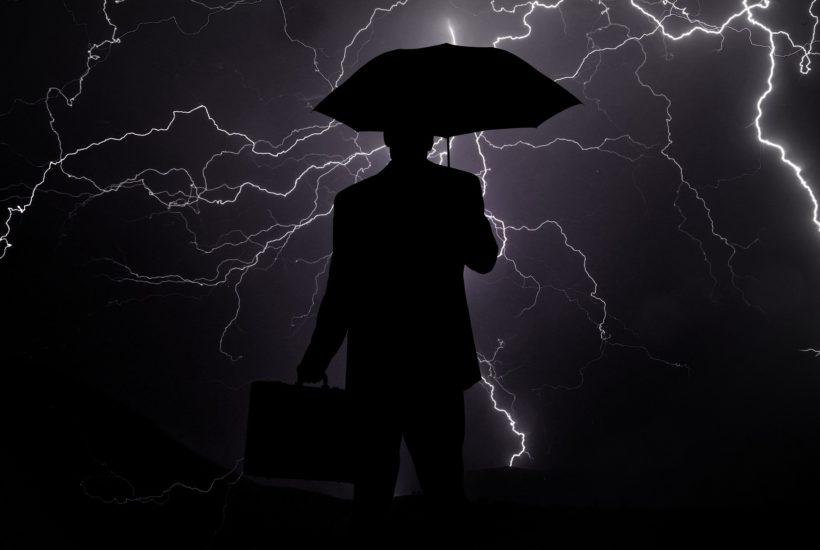Business
The V-shaped economic recovery is just an illusion
What we are witnessing now is the economic equivalent of a person’s bounce off a trampoline after a 1,000-foot cliff dive. That is, a dramatically sharp ascent from the bottom but nowhere near from whence you started—and with a quick retreat back down from that much lower high. At the core of this “V”-shaped illusion is the $2.3 trillion fiscal stimulus already approved by D.C.

We start this week’s commentary with some rather depressing news from Reuters:
The ratio of downgrades to upgrades in the credit ratings of leveraged loans has spiked to a record level, five times above that hit during the last global financial crisis, reflecting the unprecedented stress in risky assets due to the coronavirus pandemic. Leveraged loans, which are loans taken out by companies that have very high levels of debt, usually with non-investment grade credit ratings–tend to be used by private equity firms as a way to fund acquisitions of such companies. The U.S. leveraged lending market has grown to more than $2 trillion, up 80% since the early 2010s, according to credit rating agency Moody’s Investors Service.
Add in the $1.2 trillion junk bond market and the $3.2 trillion in BBB debt, which is just barely above the junk category, and you end up with nearly six and a half-trillion dollars’ worth of corporate debt that is primed for varying degrees of default. The catalyst for this default is the worst economy since the Great Depression.
Is it any wonder why the Fed doesn’t allow even a small correction to occur in the stock market or a slight decline in GDP any longer? But perhaps it’s about time that it did. The valuation of equities is now back to an all-time high of 150% of GDP. And incredibly, just three stocks (AAPL, AMZN, and MSFT) are valued at $4.4 trillion. This means Wall Street has deemed it ok that just three companies have the same worth as 22% of the entire U.S. output per year. Of course, this makes Mr. Powell’s cronies, along with the top 10% of households—who own 88% of stocks—most happy for sure.
The consumption-driven U.S. economy is under attack from many angles. There are still 29 million people collecting some form of unemployment insurance. This includes the over 9 million “off balance sheet” individuals covered under the Pandemic Unemployment Assistance program that the MSFM and the White House are fond to ignore.
We also have 2.2 million people that are finding gainful employment inside Zombie companies. Unfortunately, these businesses were being kept alive by record-low borrowing costs for junk debt and a reasonably good economy. However, now the cost of rolling over this debt has increased while their business models have been torpedoed by the Wuhan virus.
The major averages are struggling to get back towards all-time highs, but the underlying economic support is disintegrating quickly. Hence, the economic chasm between the rich and poor is plunging deeper into record depths. But the mirage of semi-normalcy is being perpetuated by massive and unprecedented fiscal and monetary stimuli.
Therefore, what we are witnessing now is the economic equivalent of a person’s bounce off a trampoline after a 1,000-foot cliff dive. That is, a dramatically sharp ascent from the bottom but nowhere near from whence you started—and with a quick retreat back down from that much lower high. At the core of this “V”-shaped illusion is the $2.3 trillion fiscal stimulus already approved by D.C.
Now, the house has approved an additional $3 trillion package known as the HEROES Act; but the Senate Leader McConnel only wants $1 trillion. And, the President has indicated that he desires to split the difference with a $2 trillion package. Of course, all of it will be monetized courtesy of Fed Chair Jerome Powell. But here’s the point, none of this new red ink is guaranteed to be passed into law, and even it is, there is no chance such budgetary lunacy can continue. The national debt is already at $26 trillion and that is 850% of annual revenue. Our fiscal deficit for 2020 is slated to come in at record-breaking $4 trillion (20% of GDP). And, total U.S. debt has soared to $72 trillion! A continued pace of this red-ink hemorrhaging would surely place our bond market in the ICU. In truth, it is already on the life support system of the Fed that has expanded its balance sheet by $6.4 trillion in the last dozen years to keep the Treasury’s debt service payments low and the government appearing solvent.
This leads us to the fiscal cliff diving exhibitions coming in August and early 2021. The over $1.1 trillion in the PPP program will be mostly exhausted, $260 billion in enhanced unemployment insurance expires, the $330 billion given to state and local governments will have been already wasted, and the $290 billion in helicopter money given to households making under $198k will be spent. Therefore, unless there is another multi-trillion-dollar rescue plan passed come this fall, the economy will go over Niagara Falls without a barrel. Of course, even if the democrats and republicans agree to force Mr. Powell to produce more monetary magic before August arrives, the inevitable free fall will still occur. And, even in the event of a relatively small infrastructure package getting through congress, the vast majority of aid to consumers and businesses will expire in the February thru May 2021 timeframe.
So, which path will the Fed and D.C wander? Will they keep on borrowing and printing multiple trillions of dollars each year until stagflation destroys all asset prices, and the market for Treasuries disintegrates? Or, will they voluntarily cut off the fiscal and monetary spigots and watch the Greater Depression unfold before them? I have a good idea as to the direction they will take, but I’ll be prepared to try and profit from their inextricable conundrum either way.
—
(Featured image by Gerd Altmann via Pixabay)
DISCLAIMER: This article was written by a third party contributor and does not reflect the opinion of Born2Invest, its management, staff or its associates. Please review our disclaimer for more information.
This article may include forward-looking statements. These forward-looking statements generally are identified by the words “believe,” “project,” “estimate,” “become,” “plan,” “will,” and similar expressions. These forward-looking statements involve known and unknown risks as well as uncertainties, including those discussed in the following cautionary statements and elsewhere in this article and on this site. Although the Company may believe that its expectations are based on reasonable assumptions, the actual results that the Company may achieve may differ materially from any forward-looking statements, which reflect the opinions of the management of the Company only as of the date hereof. Additionally, please make sure to read these important disclosures.

-

 Cannabis1 week ago
Cannabis1 week agoSwitzerland Advances Cannabis Legalization with Public Health Focus
-

 Crowdfunding3 days ago
Crowdfunding3 days agoEquity Crowdfunding in Europe Surges to €160M in H1 2025 Amid Market Resilience
-

 Fintech1 week ago
Fintech1 week agoRipple and Mercado Bitcoin Expand RWA Tokenization on XRPL
-

 Crypto10 hours ago
Crypto10 hours agoXRP Hits New All-Time High Amid U.S. Crypto Policy Shift and Ripple’s Expansion
























